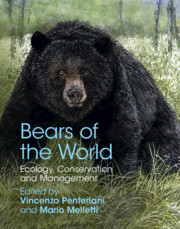Book contents
- Bears of the World
- Bears of the World
- Copyright page
- Dedication
- Frontispiece
- Contents
- Contributors
- Foreword
- Acknowledgments
- Introduction
- Part I Systematics, Ecology, and Behavior
- Part II Species Accounts
- Part III Human–Bear Coexistence
- Chapter 15 Human–Bear Conflicts at the Beginning of the Twenty-First Century: Patterns, Determinants, and Mitigation Measures
- Chapter 16 Principles of Human–Bear Conflict Management in Challenging Environments
- Chapter 17 Patterns of Bear Attacks on Humans, Factors Triggering Risky Scenarios, and How to Reduce Them
- Chapter 18 Effects of Human Disturbance on Brown Bear Behavior
- Chapter 19 Bears in Human-Modified Landscapes: The Case Studies of the Cantabrian, Apennine, and Pindos Mountains
- Part IV Conservation and ManagementConservation and Management
- Index
- Miscellaneous Endmatter
- Plate Section (PDF Only)
- References
Chapter 18 - Effects of Human Disturbance on Brown Bear Behavior
from Part III - Human–Bear Coexistence
Published online by Cambridge University Press: 16 November 2020
- Bears of the World
- Bears of the World
- Copyright page
- Dedication
- Frontispiece
- Contents
- Contributors
- Foreword
- Acknowledgments
- Introduction
- Part I Systematics, Ecology, and Behavior
- Part II Species Accounts
- Part III Human–Bear Coexistence
- Chapter 15 Human–Bear Conflicts at the Beginning of the Twenty-First Century: Patterns, Determinants, and Mitigation Measures
- Chapter 16 Principles of Human–Bear Conflict Management in Challenging Environments
- Chapter 17 Patterns of Bear Attacks on Humans, Factors Triggering Risky Scenarios, and How to Reduce Them
- Chapter 18 Effects of Human Disturbance on Brown Bear Behavior
- Chapter 19 Bears in Human-Modified Landscapes: The Case Studies of the Cantabrian, Apennine, and Pindos Mountains
- Part IV Conservation and ManagementConservation and Management
- Index
- Miscellaneous Endmatter
- Plate Section (PDF Only)
- References
Summary
Humans disturb bears in many ways, either directly when they encounter humans or indirectly by changing their behavior and way of life to avoid humans, human activity, and infrastructure. Here we summarize research on how brown bears normally react when encountering humans, what a human encounter may entail for a bear, and whether bears habituate or change their behavior toward humans with increased exposure. Based on this, we also discuss: (a) how our knowledge of brown bear behavior may help people to deal with their fear of bears, and not limit their use of outdoor areas with bears; (b) how human presence, activity, and infrastructure have an indirect effect on bears, that is, how bears change their movement pattern, use of terrain and vegetation, and daily activity pattern to avoid humans; (c) how human disturbance influence foraging and denning, which is crucial for brown bear growth and reproduction; and (d) apparent differences among continents in brown bear behavior toward humans and whether this may have an evolutionary cause.
- Type
- Chapter
- Information
- Bears of the WorldEcology, Conservation and Management, pp. 250 - 259Publisher: Cambridge University PressPrint publication year: 2020
References
- 2
- Cited by

